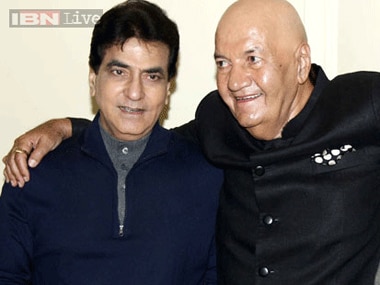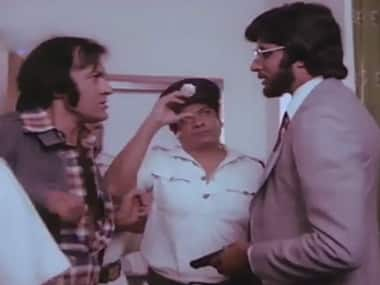Editor’s note: Prem Chopra may have started out as a complete outsider, but after more than 50 years in Bollywood, he’s become one of its most beloved icons despite having been the one who beat up heroes and violated heroines. In his biography, Prem Naam Hai Mera, Prem Chopra, the actor reminisces to his daughter Rakita Nanda about his time in Bollywood, from the early days of struggle to now. Here are selected excerpts. [caption id=“attachment_1650517” align=“alignleft” width=“380”]  Courtesy: ibn live[/caption] I was living in block B of Usha Sadan those days, and as I stepped out for work each morning, I would notice another guy coming out of block C, who looked about the same age as I. Both of us would pretend to be busy and move on. But when we also started catching sight of each other waiting outside producers’ cabins in the studios, we introduced ourselves. “Hi, I am Prem.” “Hi…Ravi,” he replied. We shook hands. Observing that both of us drove our cars, I decide to talk to him. “We need to stop pretending we are busy. We go to the same places and have the same agenda. Let’s do a car pool. The day I take my car, I will also pay for your lunch and tea, and the next day will be your turn to do the same.” It was a reasonable proposal and Ravi instantly agreed. ….We were crossing Chowpatty one day when two girls asked for a lift. One was attractive, while the other wasn’t as much. Ravi asked me to stop the car and when I saw the objects of his interest, I braked instantly. My Herald had two doors. Ravi got out of the car to help the girls in and then sat next to the more attractive one in the back seat, while the average girl sat next to me. I started talking in ‘made-up’ Tamil, making fun of Ravi. The girls turned to Ravi and asked, “What is he saying?” Ravi replied cheekily, “He is saying he likes the girl sitting in front very much.” I rolled my eyes. [caption id=“attachment_1650469” align=“alignleft” width=“380”]  Courtesy: ibn live[/caption] We took them to a theatre in Mahalaxmi to see the film Neela Akash (1965). The girls told us they were Muslims and as they were keeping their rozas during the holy month of Ramzan, they would break their fast with us in the evening. During the interval, I took Ravi aside and told him, “Look, it is my turn to take care of the day’s expenses, but I simply do not have enough money for a feast for these girls. Let us scoot.” Ravi agreed, his pockets were empty too, and we slipped out of the theatre. We just left the girls there..… Ravi, better known as Jeetendra, made it big in Hindi films, and our friendship endured for decades to come. *** I often wondered how my children felt seeing me play a bad man and getting beaten up on screen by Amitabh Bachchan. While millions of fans adored him, do you think my kids ever liked him? My kids were constantly told that Papa just plays the bad man. This had to be understood; it was a job that resulted in a good education for them. So they shouldn’t believe what they see on the screen… I remember finding Amitabh respectful and cultured. He had a good educational background and it showed in his conduct. We got along well. Amitabh never bragged about himself. But yes, he was confident from the word go. During the making of Gehri Chaal, he was going through a bad patch. Sridhar, a filmmaker from the South, turned up for a meeting and said, “If this film doesn’t work, I will be out of business.” Amitabh looked at him and said, “I’ve been doing second, third and fourth leads in films for a while. I’m going through a rough patch. But I know I’ll bounce back. I will occupy the top slot and stay there.” He made it big. And it was sheer confidence, not overconfidence that catapulted him to where he is today, an artiste who braved and survived the winds of change. … Amitabh and I went on to do a lot of films together in his angry young man phase in the ‘70s. … Most of these films did well. [caption id=“attachment_1650503” align=“alignleft” width=“380”]  A screengrab from youtube.[/caption] In almost all the films, I was beaten up by him in the end. I must mention that Amitabh was an exception, otherwise it was very embarrassing to be beating up by a five-foot-something hero. It may sound incredible, but in Hindi films it is a routine occurrence. Amitabh and I had a lot of fun together. When I had to bash him up, I would solicitously enquire after every shot if he was hurt. Perplexed, he finally asked me, “Why are you so concerned?” I replied, “Because when it is my turn to be clobbered, I want you to be similarly concerned!” Trishul, my second movie with Yash Chopra, was produced by Gulshan Rai. It was a resounding success and one of the top grossers of 1978. It was remade in Tamil as _Mr Bharath (_1986), starring Rajinikanth. I found Yash to be a meticulous director. He believed in assembling a complete script before the film went on sets. Though he was an involved filmmaker, he was fairy easy-going on the set….… During Trishul, Shashi Kapoor, Amitabh and I were drinking at the Oberoi. Those days Amitabh enjoyed drinking. After three drinks, he started playing the sitar and we lost count of time. Finally one of us threw back the curtains and realised to our shock that it was almost dawn. Shashi and I decided to go back to our rooms. I was so drunk by now that I was supporting myself against the walls as I walked up to my room. The joke that made the rounds later was that if anyone had opened a door before I reached my room, I would have walked straight in and tumbled into bed in that room. That morning, we were on time for the shoot. Yash was very happy and said, “See how punctual my boys are – they are here on the dot at 7.” We had a hearty laugh because all of us were actually dropping off to sleep. *** Many people are interested in knowing my emotions as I performed all those rape scenes. I shared perfect harmony with my female co-stars during such shots. I was very professional and ensured no untoward incident ever took place. … No heroine has ever declined to work with me. By the ‘80s I had been in the industry for almost twenty-five years and achieved a certain standing. Of course, some heroines weren’t professional or cooperative to start with, but they all had to buckle down to the director finally. However, the most cooperative star I’ve ever worked with is Hema Malini. She was a surprise. When I first worked with her I used to wonder how she would be able to do such [rape] scenes, for she appeared totally disinterested during rehearsals. The final shot was always fantastic; she was probably saving her best for the last. One of my best rape scenes has been with her in Aas Paas and she was cooperation personified. … Most of the films of that time never showed the actual act; it was left to be conveyed through objects and sound effects. Like Aas Paas, where the hint of rape is only through dialogue, after which I leave a hundred-rupee note in an empty alcohol bottle while Hema Malini lies with dishevelled clothes. The music takes over. Do you think I actually like doing all these dirty things on screen? No, I do not! Violence and sex may be phases of the contemporary scene but I totally against glorifying violence or dishing out sex as a box office booster. By the mid-1970s, film producers had already been told by the government to reduce violence and rape scenes. Even the films that were already on the floor had to conform by the new directive from the centre. People thought I was one of the coolest rapists to have ever graced the Hindi film screen. Picture this…I wear Coke-bottle glasses in Andha Kanoon, exactly a decade after Daag. I try to rape Reena Roy, who is wearing culottes that have all those ridiculous zippers. The goons have locked her in the house when she sees me. The dialogues go something like this… Reena Roy, screaming at no one in particular, bangs on the door: Darwaaza kholo! (Open the door!) PC [Prem Chopra] laughs menacingly: Bhagwaan bhala kare jab tak main nahin kahoonga, darawaza koi nahin kholega. (No one will open the door until I say so.) More dialogue follows and then my laughter rings out menacingly while I proceed to rip open her zippers, two on each calf, one each on the arms. The sound effect of the zippers is exaggerated while she keeps screaming “Naheeeeein”. Nothing is actually shown. The audience is kept on edge only by imagination. … Unfortunately, the emphasis at that time was on the humiliation and suffering of the victim, who would die or commit suicide in the film. This treatment sends out wrong signals to society. Shame was attached to the rape victim instead of focusing on society’s perversity (as perpetrators, bystanders, voyeuristic consumers and law makers). *** In that era [’60s-’80s], the movie comprised one main villain, the hero and heroine, plus a comedian. The whole plot revolved around these characters. A cabaret and a rape would be thrown in and the picture was complete. The poor antagonist was therefore shouldered with delivering a great deal of villainy within the shortest possible time in a most meaningless manner. … The villain changed through the decades, reflecting the socio-economic circumstances of each era. The ‘50s’ munim gave way to the ‘60s’ dacoit who stepped aside for the ‘70s’ smuggler who fell by the wayside for the ‘80s’ politician, who to his credit, still reigns strong. Of course, in the new computer age, we even have the robot cast as a villain. Power is the oppressor. … A journalist asked me recently, “What’s it like to be Bollywood’s best-loved mad man?” My reply was, “That stage is past. I’m now playing positive roles. You’ll see me as a grandfather in my next films.” Prem Naam Hai Mera Prem Chopra, Rakita Nanda, Rainlight (Rupa Publications India), Rs 495
In his biography, Prem Naam Hai Mera, Prem Chopra, the actor reminisces to his daughter Rakita Nanda about his time in Bollywood, from the early days of struggle to now. Here are selected excerpts.
Advertisement
End of Article
Written by FP Archives
see more


)
)
)
)
)
)
)
)
)



